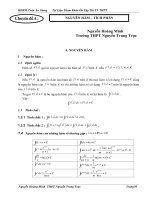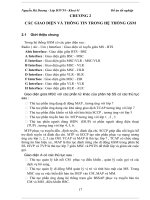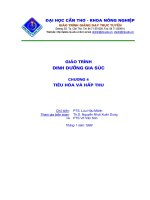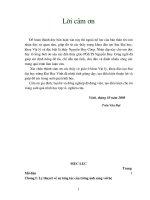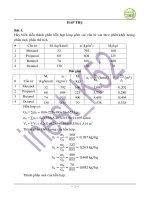Đất 4 - tích điện và hấp thụ pptx
Bạn đang xem bản rút gọn của tài liệu. Xem và tải ngay bản đầy đủ của tài liệu tại đây (1.88 MB, 78 trang )
Chương 4
tích điện và hấp thụ
Nguyễn Kim Thanh
2008
TÍNH HẤP PHỤ (sorbsion) CỦA
ĐẤT
•
Tích điện bề mặt;
•
Cation trao đổi và khả năng trao đổi
cation;
•
Lớp khuếch tán;
•
Hấp phụ chọn lọc;
tích điện bề mặt
1. Sự tích điện bề mặt vĩnh cửu do khóang
2:1 và khóang 2:2
2. Sự tích điện phụ thuộc pH
-
Sét 1:1
-
Carboxyl và phenolic
3. Tích điện âm và tích điện dương do oxyt
Fe và Al
Tóm tắt chung - Các micelle
Silicate tinh thể - Crystalline Silicates
1:1, 2:1 (expanding and non-expanding), 2:1:1
Silicate không tinh thể - Non-Crystalline Silicates
Allophane and Immogolite (sản phẩm của tro núi lửa)
Các ôxit: Fe and Al Oxides /Hydroxides/ Oxyhydroxides
Geothite, Gibbsite, Hematite, Ferryhydrite, Maghemite
Mùn hữu cơ- Organic Matter (humus)
High and Low Molecular Weight Acids (Fulvic, Fluvic, Hemic)
nguyên lý tích điện
Sự thay thế Si bởi Al và thay thế Al bởi Mg
- - - - - - - - -
O
6
- - - - - - - - -
O
6
- - - - K
+
- - -
O
6
Si
4
Si
4
Si
3
Al Tetrahedral
O4(OH)
2
O4(OH)
2
O4(OH)
2
Al
4
Al
4
(Al,Mg,Fe)
4
Octohedral
(OH)
6
O4(OH)
2
O4(OH)
2
Si
4
(SI
3
Al) Tetrahedral
- - - - - - - -
O
6
- - - - - - - - -
O
6
- - - - K
+
- - -
kaolinite Pyrophylite Thay thế 2:1
Ví dụ thay thế đồng đẳng (Isomorphic
Substitution)
1:1 phyllosilicates: kaolinite
•
1 lớp Si: tetrahedral
•
1 lớp Al: octahedral
•
Các khoáng liên kết
với nhau bằng liên
kết Hydro (H bonds)
SILICA TETRAHEDRON STRUCTURE
siO
4
2:1 Phyllosilicates: di and trioctahedral
Dioctahedral (smectites)
•
Thay thế 3
+
bởi 2
+
trong
lớp octahedral (đồng
đẳng)
•
Tạo 1 lượng tích điện
ròng
•
Tạo ra nhiều lớp mở
rộng
Trioctahedral (vermiculite)
•
Thay thế 4
+
bởi 3
+
trong
lớp tetrahedral
•
Cũng tạo CEC, nhưng
không mở rộng lớp
•
Phyllosilicates: continuous sheet of Tetrahedral, each
sharing 3 oxygen (also called sheet structures)
1:1 Layer Silicates
Kandite Group: kaolinite, dickite,
nacrite
Serpentine Group: lizardite
2:1 Layer Silicates
Pyrophyllite/Talc Group: pyrophyllite
Smectite Group: soil_smectite
Vermiculite Group: vermiculite
Mica Group: muscovite, biotite,
lepidolite, margarite
2:2 or 2:1:1 Layer Silicates: chlorite
Interlayered Phyllosilicates
Cấu trúc khoáng sét of 2:1 Clays
•
Tetrahedral sheet
•
Octahedral sheet
•
Tetrahedral sheet
VD cấu trúc đơn giản nhất của tetrahedron
•
Tetrahedron
–
1 ion silicon bao
quanh bởi 4 nguyên
tử oxy.
•
Tetrahedral sheets
–
Các lớp tetrahedral
(tetrahedral sheets)
được gắn với nhau
bởi chia nhau các
nguyên tử ôxy
Tám cạnh của Octahedron
•
Octahedron
–
6 oxygen với nguyên
tử Al
3+
trung tâm
•
Octahedral sheet
–
Các lớp Octahedral
(sheets) cũng gắn với
nhau bởi chia nhau
các nguyên tử oxygen
VD 2 lớp octahedral
Octahedral Sheet
Phyllosilicates (Clays)
A. 1: 1 Khoáng silicate tạo lớp: một lớp
Tetrahedral Si và một lớp Octahedral Al
VD: Kaolinite, Halloysite không có cation
nằm giữa các lớp. Các lớp chủ yếu liên
kết với nhau bởi liên kết Hydro (H-bond)
B. 2:1 Khoáng silicate tạo lớp 2:1: một lớp
Octohedral nằm chính giữa chia sẽ Oxy
với 2 lớp Tetrahedral VD:
Montmorillonite, Illite, Vermiculite etc
Phân loại sét 2:1 Clay dựa trên:
1. Kiểu và lượng thay thế đồng đẳng trên lớp tetrahedral và
octahedral
2. Độ lớn tích điện mỗi phân tử (layer Charge)
3. Loại cation nằm giữa các lớp
Example of a 2:1 layered silicate
muscovite
C. 2:1:1 các lớp silicate giống như 2:1
nhưng thêm 1 lớp Al ví dụ Chlorite
Properties of Layer Silicates
•
KAOLINS:
•
A 1:1 Phyllosilicate typified by Kaolinite
Composition: 39.8% alumina, 46.3% silica, and 13.9% water
Unit Cell Formula: [Al
2
Si
2
O
5
(OH)
4
],
-Si
4+
in tet sheet, Al
3+
, Mg
2+
in oct sheet
Effective Diameter: 0.2-2.0µm
Found in Highly weathered soils in coarse clay fraction & sediments
Other members of Group: Halloysite, Dickite, Antigorite
c-spacing = 1.0nm
Properties:
* H-bonding b/w sheet prevents expansion beyond its basal spacing of 0.72nm
Structure of kaolinite (1:1)
Kaolin (Contd)
* Surface Area: 10 to 20 x 10
3
m
2
kg
-1
* Al/Si ration =1 indicating absence of Iso
Substitution
* Low colloidal activity
* low plasticity
* low cohesion
Cation Exchange Capacity (CEC)= 10-
100mmol(+)kg-1
-CEC= due to dissociation of OH
-
CEC due mostly to pH-dependent Charge
SMECTITES (Montmorillonite)
•
They are 2:1 layer clays
–
Examples are Montmorillonite, Beidellite
•
Half Unit Cell formula: Na
x
(Al
2-X
Mg
x
)Si
2
O
10
(OH)
2
•
Layer Charge: 0.25-0.6/formula unit
–
Low layer charge responsible for high degree of
expansion
C-spacing= varies with exch. Cation & interlayer
solvation
C-spacing: Dry .95-1nm; wet >10nm
Smectites vary depending on predominant octahedral
cations
Structure of Montmorillonite (2:1)
SMECTITES (Montmorillonite)
•
Properties:
CEC= 800 -1200 mmol(+)kg-1
Surface Area: 600 to 800 x 10
3
m
2
kg
-1
Common in temperate soils e.g Vertisols in the fine clay
(.01-1µm) fraction
Exhibit imperfect isomorphic substitution
•
b/c Al
3+
sub for Si
4+
in tet & Fe
2+
sub for Al3+ in Oct.
•
High Shrink-Swell potential
•
High Plasticity
•
High Cohesion
2:1 Clay: Vermiculite
•
Found in soils formed from weathering or hydrothermal
alteration of Mica
•
Both octahedral and dicoctahedral verm. Exist
•
C-spacing =1.4-1.5nm
•
Half unit formula:
[Mg(H
2
0)
6
]
n/2
[(Mg, Fe
2+
)
3
(Si
4-n,
Al
n
) O
10
(OH)
2
]
Note that the hydrated Mg cation is the exchangeable cation
Layer Charge or CEC= 1200-1500 mmol(+)kg-1
Vermiculite swells less than Mont b/c higher charge

